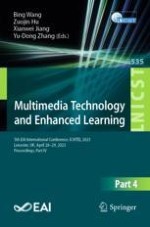2024 | Book
Multimedia Technology and Enhanced Learning
5th EAI International Conference, ICMTEL 2023, Leicester, UK, April 28-29, 2023, Proceedings, Part IV
Editors: Bing Wang, Zuojin Hu, Xianwei Jiang, Yu-Dong Zhang
Publisher: Springer Nature Switzerland
Book Series : Lecture Notes of the Institute for Computer Sciences, Social Informatics and Telecommunications Engineering
